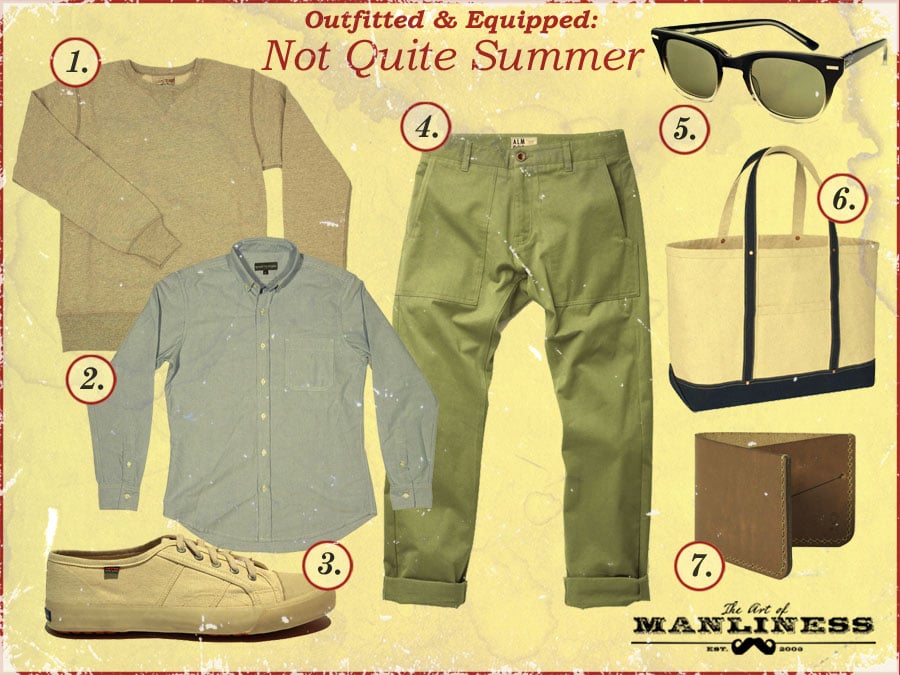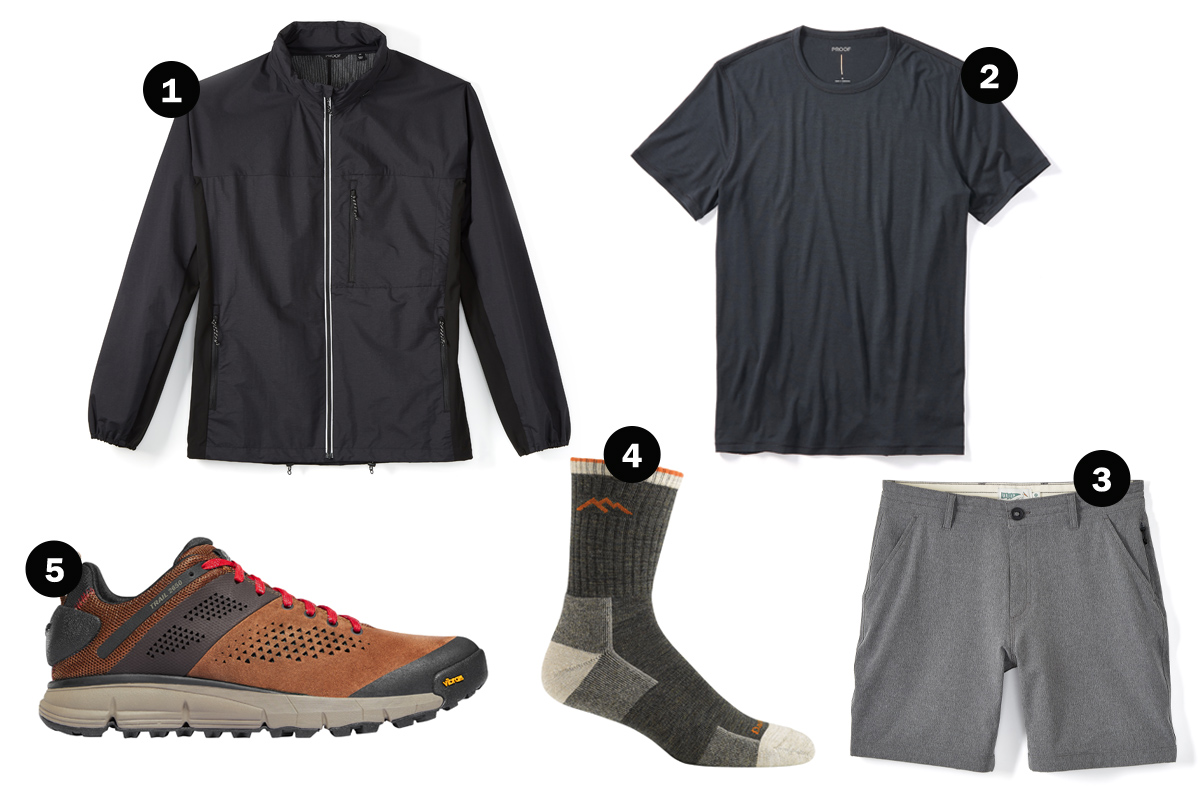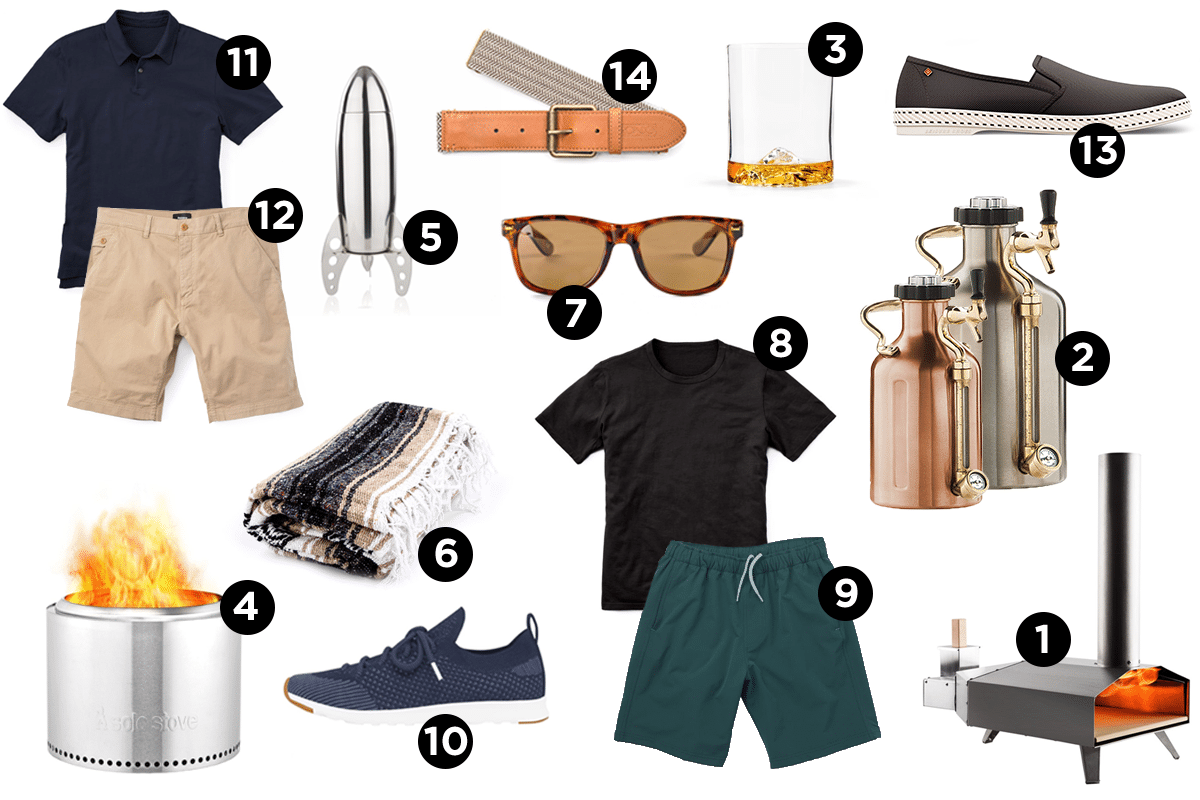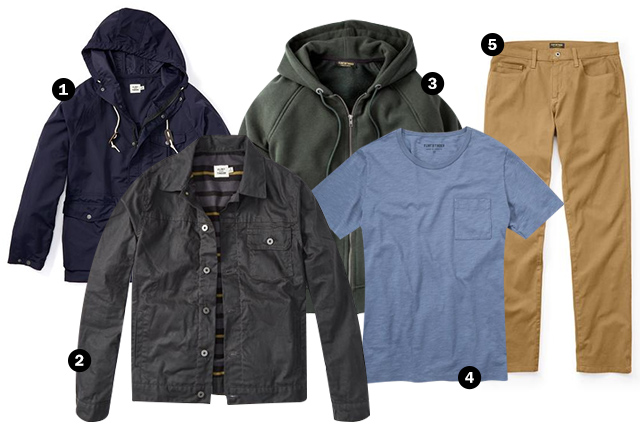Whenever I post videos of me lifting on AoM’s Instagram account, I get a lot of questions about the gear and clothing I use while training. To satiate this interest, I figured I’d answer all those questions in one fell swoop by doing an “Outfitted and Equipped” of my entire workout get-up. These are the things that I use and have found success with; your mileage may vary.
Everyday Items
0. Old School Labs Vintage Blast Pre-Workout. About 30 minutes before training, I drink some Old School Labs Vintage Blast. It’s an all-natural pre-workout supplement that’s sweetened with stevia. It has what you’d typically find in a lot of pre-workouts: beta alanine, L-carnitine, and, of course, caffeine. I drink Vintage Blast primarily for the caffeine boost and because I enjoy its decently refreshing blueberry lemonade flavor. Also, I kind of look like the guy on the label, and that’s cool.
1. PT shorts. My preferred shorts are AoM’s “Strength and Honor” PT shorts or The Strenuous Life PT shorts (which members receive free when they sign up, but aren’t available to those outside the program). Made by Soffe, this style of short is standard issue to new Army recruits, who wear them during PT training. I find they’re just the right length: shorter than basketball gym shorts, but not as short as ranger panties. They don’t get in the way of my deadlifts and power cleans and the flexible, lightweight material keeps me cool, and stretches with my movements.
2. Any old t-shirt. I don’t use any sort of “performance” shirt that wicks away sweat. Just any old cotton or cotton-poly graphic t-shirt that I have in my collection. Most of my workout tees are AoM tees, though I do have lots of other freebie t-shirts that I’ve accumulated from events and races and whatnot. My favorite tee to wear is the AoM Barbell Club Ringer tee. Nothing special about it; I just like how it looks.
3. Tube socks. Anytime I post a picture of me lifting, I always get comments about my 1980s dad tube socks. The main reason I wear them is to protect my shins while deadlifting; don’t want to scrape them while the bar is going up my legs. But I even wear them when I’m not deadlifting. Why? Because I like them.
Go for the 25-inch knee-high socks.
4. Constrictor Wrist Wraps from Elitefts. Wrist wraps help keep your wrists in a nice, straight, neutral position while shoulder pressing or bench pressing. While I only wear wrist wraps when performing those lifts, some lifters also wear their wraps while squatting to ensure their wrist doesn’t bend during the exercise.
I use the Constrictor Wrist Wraps from Elitefts. My Barbell Logic coach Matt Reynolds gave me his old ones a few years ago and I’ve stuck with them. They get the job done.
5. Super Heavy Knee Sleeves from Elitefts. I wear these knee sleeves when I squat. They keep your joints warm and provide a bit of support around your knees to keep you safe while you’re hefting 300 pounds on your back. The sleeves shouldn’t be so tight that they practically cut off circulation to your legs. If that’s the case, the sleeve is acting more like an aid to the lift instead of merely supporting the knee. Knee wraps are in fact typically worn tight by powerlifters for just that reason — as a kind of brace when squatting.
I use the Super Heavy Knee Sleeves from Elitefts. These were another hand-me-down I got from Reynolds when I started working with him three years ago, and I’ve been using them ever since. They’re a little thicker than most knee sleeves, but not so thick that they become blood-choking tourniquets. I can wear them comfortably throughout my workout.
6. Adipower Weightlifting Shoes. I’ve had this pair of Adidas lifting shoes for four years and they’re still going strong. If your lifting program involves squats, presses, and deadlifts, you need a pair of lifting shoes. Why? A few reasons:
First, a lifting shoe has an incompressible sole which helps ensure you get the maximal amount of force transmission during your lifts. When you squat, press, or deadlift in a pair of cushion-y running shoes, you lose some of that force. Think of it this way: if you were squatting, would you want to squat while standing on a mattress or a hard floor? A hard floor, of course. The lift will just be more efficient.
Reason #2 you need weightlifting shoes: they have an elevated heel. The elevated heel helps move your knees forward a bit which allows you to use your quads a little more during the lift, which helps make the squat more efficient. The elevated heel is especially important if you do a lot of Olympic lifting. For most people, a weightlifting shoe with a ½” to ¾” heel is adequate.
And reason #3: lifting shoes have a metatarsal strap which increases stability in the shoes and helps prevent your feet from moving around inside of them while you’re lifting.
Lifting shoes will run you from $70 to $200. My Adidas ones were $125. Expensive? A bit. But I’ve been using them for four years and they probably have several more years of use in them. So the cost per use is actually pretty low.
I wear my lifting shoes when I squat, press, and bench. I wear them for the deadlift when I’m warming up for the lift or doing volume work. But I’ll take off my shoes and lift in slippers or socks when I’m performing heavy singles of the deadlift. Lifting without the elevated heel helps reduce the range of motion required in deadlifting which makes for a more efficient lift, though, there are lots of people who do all their deadlifting in their lifting shoes.
7. 3” Weightlifting Belt from Best Belts. We’ve talked about what a weightlifting belt does in depth before; read that article. Summary: it helps you tighten the muscles in your core so that you can lift more efficiently.
A proper weightlifting belt has the same width all around the waist. There’s no goofy-looking larger back. It’s also made of leather and has a prong or lever buckle — no velcro straps here, which have a tendency to come undone while you’re lifting.
Most belts come in 3” or 4” widths. Powerlifters often go with a 4” belt. I use a 3” belt because I find it more comfortable, especially when I’m deadlifting.
There are lots of great companies out there making quality belts. Rogue, Pioneer Fit, and Dominion Strength are a few of them. I got mine from Best Belt. They make it custom just for you. You give them your waist size and in a few weeks you’ve got a quality belt that will last you forever. I’ve had mine for three years and will probably be using it until I die.
Look to spend $100-$150 for your belt.
Occasional Use Items
8. Slingshot Hammy Bands. Sometimes I deal with adductor tendonitis when I squat. It’s not a constant problem; it just pops up every now and then. This condition causes a pain and discomfort in your groin area. It just feels really tight in that area and makes getting down to depth not very much fun. I have a treatment regimen that I use for adductor tendonitis, and it includes wearing some Hammy Bands from Slingshot. The compression helps reduce the pain while squatting.
9. Slingshot Elbow Cuff. I’ve also been battling bicep tendonitis for a few years now. I have it mostly under control, but every now and then it flares up pretty bad, especially when I bench press. It feels like a dull, achy pain in my inner elbow. On days when my bicep tendonitis decides to get cranky, I slap on my elbow cuffs from Slingshot. The compression helps reduce the pain so I can bang out my bench press. After I train, I’ll immediately start doing my bicep tendonitis treatment regimen.
10. Lifting Straps from Harbinger. As my deadlifts get heavier, I’ve started using lifting straps. I only use them on heavy volume deadlift sets (if I’m doing a working set with a weight above 400 pounds) or rack pulls (deadlifting a bar that’s already elevated within the rack). It allows me to perform the lift and not worry about my grip going out. I still do my heavy single deadlifts without straps since you can’t wear straps during competition and it helps train my grip.
Straps come in all sorts of materials — cotton, leather, seat belt webbing. The Harbinger straps that I use are made from heavy-duty cotton and have been holding up well.
If you’re just starting out with strength training, you don’t need straps. Wait until your working sets get pretty dang heavy.
Finally, I’m often also asked about what kind of squat rack I use. I’ve got a Power Cage from Fringe Sport based in Austin, TX. I’ve been using it for four years now and am happy with it. It’s allowed me to train safely alone in my garage thanks to the safety pins (which will catch the bar if I get stuck with the weight on me while squatting or benching). A big selling point for me was the Power Cage’s 91” height; I’ve got a low ceiling in my garage, so finding a squat rack that fits its dimensions was difficult. The rack’s also got a pull-up bar and I bought a dip attachment so I can do those supplemental exercises in addition to my main lifts.








